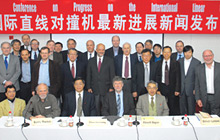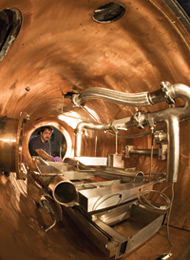|
Toward an
International Linear Collider By Elizabeth Clements, ILC Global Design Effort The ILC reached a major milestone when it presented the first detailed technical snapshot of the machine in Beijing. The announcement marks the beginning of the engineering phase of the project.
|
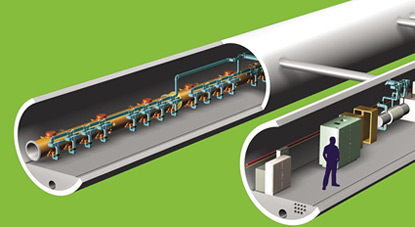 |
| An artist's rendering of the tunnels inside the International Linear Collider. Illustration: Fermilab |
|
Higgs Boson. Dark Matter. Dark Energy. Extra Dimensions. These are all buzz words that will make the heart of any particle physics enthusiast flutter. The International Linear Collider, a proposed next-generation accelerator, recently took one step closer to discovering exactly what makes these words buzz. On February 8, 2007, at a press conference held at the Institute of High Energy Physics in Beijing, China, the International Committee for Future Accelerators (ICFA) announced the release of the Reference Design Report for the ILC. “This is a major next step in the development of the ILC,” said Albrecht Wagner, ICFA chair and director-general of the German laboratory DESY. “In recent years, many steps have been taken toward building an ILC. The work on the ILC has been scrutinized and reviewed by many international bodies and has received strong encouragement and support for moving forward with this project.” |
Gateway to the Quantum Universe
In the last 10 years, scientific observations have revealed a universe far stranger and more wonderful than people had ever imagined: a universe filled with dark matter and dark energy, where ordinary matter is only a tiny minority. The next generation of particle accelerators will stretch our imagination even further. It might reveal new forms of matter, new forces of nature, and new dimensions of space and time.
Reaching these ambitious goals will be a major challenge. New accelerator-based experiments are pushing the boundaries of technology in particle acceleration, materials engineering, detector development, and computing.
The proposed International Linear Collider, a 20-mile-long particle collider, is at the forefront of these endeavors. Together with the Large Hadron Collider, scheduled to start operating at the European laboratory CERN in 2007, the ILC would answer some of science’s greatest questions about the nature of the universe. With its high-energy electron-positron collisions, the ILC would give scientists the information they need to understand nature’s mechanism to create mass, explore the intriguing properties of supersymmetry, probe dark matter candidates, and possibly discover new forces that may show the way to a unified theory.
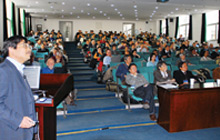 |
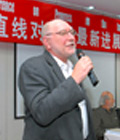 |
 |
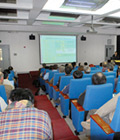 |
 |
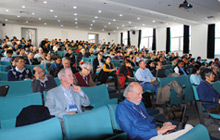 |
| Attendees at the ICFA meeting in Beijing. | ||
| Photos courtesy of IHEP, Beijing | ||
The reference design
The reference design defines the technical parameters and components that make up the accelerator. The RDR is the first technically-detailed snapshot of the proposed electron-positron collider. This report will guide the development of the worldwide R&D program, motivate international industrial studies, and serve as the basis for the final engineering design needed to make an official project proposal later this decade.
“A talented group of dedicated scientists and engineers from particle physics laboratories and universities around the world has been working together for more than a decade toward an ILC,” said Barry Barish, director of the Global Design Effort for the ILC. “In the 1990s, several of our laboratories developed the key technologies, and that has been followed by an extraordinarily productive period. ICFA made a decision to base the design on superconducting rf technology; a GDE was initiated to produce a design for the accelerator, and the first stages of the design and costing have now been completed.”
As part of producing the RDR, the GDE estimated the value of components and labor needed to complete the ILC. The estimate came out to roughly 7 billion ILC Value Units, a number that can be converted into costs in local currencies taking into consideration differences in local accounting systems. The values of components were determined by a worldwide call for bids specifying a required quality and assessing a lowest reasonable cost. (See more information on the value estimate on page 8.)
Once the Reference Design Report is internationally reviewed, the engineering phase begins. The value cost estimate will provide guidance for those optimizing the design and doing the R&D in that phase. GDE members speaking about the value estimate are confident that the value will not increase substantially as the design is optimized during the next phase of planning.
“On the behalf of the International Linear Collider Steering Committee, we appreciate the enormous effort led by the Global Design Effort,” said Shin-ichi Kurokawa, Chair of the ILCSC, an international body that promotes the construction of an electron-positron linear collider through worldwide collaboration. “We especially appreciate the last half year’s heroic effort of the GDE to make the RDR and their cost consciousness in modifying the design without compromising the physics. We have to work hard to accomplish this project, but we have a great milestone to move forward.”
Breaking new ground “The GDE has produced some extraordinary reports,” said Princeton University president-emeritus Harold Shapiro, who chaired the National Academy of Sciences’ EPP2010 Report committee. “These are inspiring documents, and they are almost unique in the field of science because they represent an international collaboration. This by itself is an enormous accomplishment.” Many universities and DOE national laboratories across the United States contributed to the worldwide effort. SLAC director Jonathan Dorfan and Fermilab director Pier Oddone both applauded this hard work and celebrated the achievement in global collaboration. “The RDR is the product of a new process in planning future particle physics installations, as it was not written by staff from one laboratory but by engineers and physicists from all over the world,” said Dorfan. “The new techniques and protocols of global collaboration that have been established for the on-time publication of the RDR have broken completely new ground.” Oddone echoed these comments. “Hard decisions were made within the particle physics community to write the Reference Design Report,” he said. “The fact that people came together across three regions is truly remarkable and bodes well for the future.” |
The “I” in ILC
Physicists have a long and very successful experience with the construction of accelerators and detectors as international projects. Recently, for example, the construction of the major detectors for the LHC has required global collaborations of physicists with significant hardware coming from Europe, Asia, and the Americas. As well as technical success in carrying out big projects, this mode of working promotes international understanding. For young people especially, the opportunity to work closely with peers from other cultures is a valuable and often eye-opening experience that breaks down cultural barriers and stereotypes.
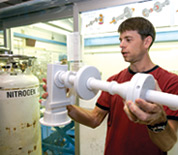 |
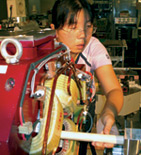 |
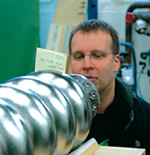 |
| A prototype of a component for the ILC. Photo: Reidar Hahn, Fermilab |
Magnets will keep particles on course as they zoom through the machine. Photo: KEK |
The International Linear Collider will use 16,000 superconducting cavities to accelerate electrons and positrons to 99.9999999998 percent of the speed of light. Photo: ILC |
In the case of the ILC, scientists and engineers will need to take this successful record of collaboration to the next level: build and operate a global facility for high-energy physics.
The GDE, and the process that led to it, has shown that it is possible for scientists from around the world to come together in pursuit of a common goal. “We can take tough decisions such as the choice of rf technology and can focus and align our R&D efforts,” Barish said. “We can exercise effective project management, despite our geographic spread and separate national funding sources.”
As the project moves towards approval and construction, the GDE intends to add greater formality to the management structure. As part of this evolution, for example, the GDE will incorporate a project management team into the next phase of the project. This new project manager and support team will not be centrally located but instead will follow the precedent established by the GDE and also operate virtually.
“Many aspects of the GDE work well, and therefore we should evolve our structures for the engineering design rather than have a complete revolution,” said Brian Foster, ILC Regional Director for Europe. “However, we certainly need a different skill set that is grounded much more in engineering.”
The GDE hopes to have a project manager in place by this summer, who will then organize the engineering effort into work packages. “We want to add project management to produce the deliverables without throwing away a lot of the things that are working well,” Foster said.
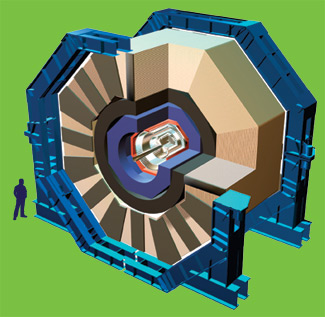 |
| The detectors will capture the array of new particles that emerge from the collision. |
| Illustration: SLAC |
Next: Global R&D
With the release of the reference design checked off the GDE’s master to-do list, the organization turns its attention to the worldwide ILC R&D program that involves the three regions: Americas, Asia, and Europe.
“The RDR will point the way for a focused worldwide R&D program on key technologies,” said Gerry Dugan, ILC Regional Director for the Americas. “In the Americas, we look forward to fully supporting the evolving machine design, contributing to the key R&D goals, and developing our regional capabilities for participation in the global ILC project.”
Defining a global R&D program that focuses on the most crucial technical aspects for successfully completing an engineering design by the end of this decade is now the highest priority for the GDE. “We need to maintain the momentum of the project,” said Brian Foster, ILC Regional Director for Europe. “We have to produce an engineering design that we believe we can build and sell to our governments in sufficient details by 2010 to allow approval for construction. We need to give them a document that allows them to say yes.”
From designing to funding to eventually building, the ILC is a global endeavor, and the release of the RDR reflects the successful international cooperation of the project.
“Accomplishing the reference design is a crucial step forward for a very challenging international scientific endeavor,” said Mitsuaki Nozaki, ILC Regional Director for Asia. “The strong international partnership has been unprecedented. We hope to keep up the international momentum in the next phase, when a coherent R&D plan will turn the reference design into a real engineering design for this global project.”
Click here to download the pdf version of this article.



